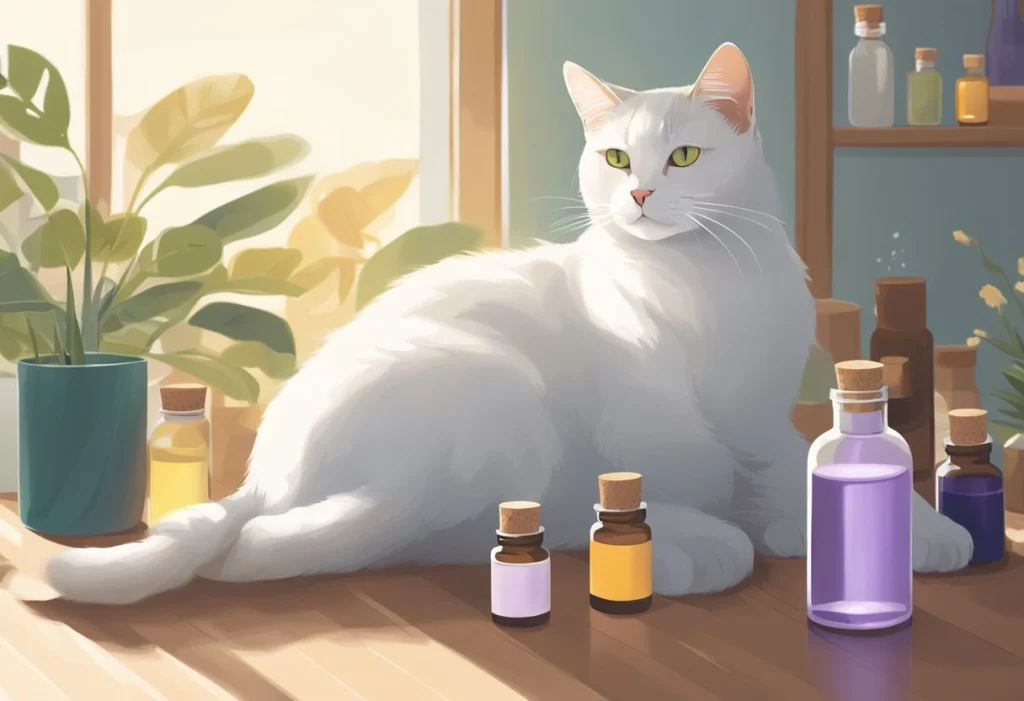Essential Oils Safe for Cats: A Guide for Pet Owners
By: Elizabeth Rikas

The information in this article is intended to educate cat parents and is not a substitute for veterinary guidance. In case of any concerns about your cat’s health, please talk with your veterinarian.
Many pet owners are curious about using essential oils in their homes, especially those with cats. It’s important to know that not all products are safe for every pet. There are no essential oils that are safe for cats, as they can be toxic even in small amounts.
Cats metabolize substances differently than humans do, making them particularly sensitive to essential oils. The ASPCA and other experts highlight the risks associated with these oils, which can lead to serious health issues for cats.
Understanding this danger is crucial for any cat owner. By staying informed, they can ensure a safe environment for their furry companions and avoid potentially harmful substances.
Click to explore: Is Catnip Safe For Cats?
Understanding Essential Oils and Their Effects on Cats
Essential oils are concentrated liquids extracted from plants. They contain aromatic compounds that can be beneficial for humans but may pose risks to cats. This section explores the components of essential oils and the common reactions cats can have when exposed to them.
Components of Essential Oils
Essential oils are made up of various components, including phenols, terpenes, and esters. Phenols are known for their strong antibacterial properties. While useful for some applications, they can be toxic to cats.
Cats have unique liver metabolism, which makes them sensitive to many compounds found in essential oils. When these oils are ingested or inhaled, they may not be processed effectively. This can lead to serious health issues, including liver damage.
Key components of essential oils include:
- Terpenes: Known for their aroma and potential therapeutic effects.
- Esters: Often used for their calming properties.
- Aldehydes: May cause skin irritation in sensitive animals.
Knowing what makes up these oils is crucial for understanding their effects on pets.
Interesting Read About World’s Smallest Cat Breed: Toybob Cat Breed
Common Reactions in Cats to Essential Oils
Cats can exhibit various reactions when exposed to essential oils. Common symptoms include:
- Respiratory distress: Coughing, sneezing, or difficulty breathing.
- Liver damage: Signs can include vomiting, jaundice, or changes in appetite.
Even small amounts of essential oils can lead to these issues. Cats may react poorly even to diluted products.
It is important for cat owners to recognize the signs of toxicity. If a cat shows unusual behavior after exposure to essential oils, immediate veterinary consultation is recommended.
Understanding these aspects can help ensure the safety and well-being of feline companions.
Click to learn how long a Persian cat lives: Persian Cat Lifespan
Safe Essential Oil Practices Around Cats
When using essential oils, it’s important to understand how to do so safely around cats. Proper practices can help minimize risks associated with diffusers and aromatherapy. Following a few guidelines ensures the safety of furry companions while enjoying the benefits of essential oils.
Proper Use of Diffusers and Aromatherapy
Oil diffusers can spread essential oils into the air. If someone chooses to use them around cats, they should ensure good ventilation. It’s best to use only a small amount of essential oil and limit the duration of diffusion.
Reed diffusers might seem safer, but they can still emit volatile compounds that are harmful. Keeping the diffuser out of reach and monitoring the cat’s behavior is crucial. If a cat shows signs of distress, such as coughing or drooling, the diffuser should be turned off immediately.
It’s also advisable to avoid direct application of oils on the cat’s fur. These practices help keep the environment safe for both pets and humans.
Safer Alternatives and Dilution Methods
When considering essential oils, some safer alternatives exist. Coconut oil can act as a carrier oil and is often seen as safer for pets. It can help dilute essential oils, reducing potential toxicity.
For those who want the calming benefits of a scent, consider using small amounts of lavender, known for its relaxing properties. This oil should always be well diluted and only used in small quantities.
Before introducing any new scent, it helps to watch for reactions. A cat’s health and safety come first, so always prioritize their well-being.
Click to explore: Majestic Siamese Cat Breed
Specific Essential Oils and Their Risks
Certain essential oils can be harmful to cats, while others may be safer options. It’s crucial for cat owners to know which oils pose risks and which ones can be used cautiously around their pets.
High-Risk Essential Oils for Cats
Many essential oils are dangerous for cats. The following oils should be avoided entirely:
- Tea Tree Oil: Can cause poisoning and neurological issues.
- Eucalyptus Oil: May lead to gastrointestinal upset and depression.
- Citrus Oils (Lemon, Lime, Orange): Can result in irritation and toxic effects.
- Peppermint: May cause respiratory problems and stomach upset.
- Lavender: Presence of toxins can lead to lethargy and other issues in high doses.
Other oils like cinnamon and bergamot are also risky. Ingesting or even inhaling these oils can lead to health complications. It is best to keep these oils away from cats and ensure that any products containing them are out of reach.
Low-Risk Options and Recommendations
Some essential oils have a lower risk of harming cats. These can be used cautiously:
- Rosemary: Generally safe in small amounts, often used in pet care products.
- Sage: Can be used sparingly for aroma but monitor for any reactions.
- Nutmeg and Spearmint: Considered low-risk, but use caution and seek professional advice.
When using any essential oil, ensure good ventilation and limited exposure. It is always advisable to consult a veterinarian before introducing any new products into the home environment. Knowing the proper usage and safety measures can help keep cats safe.
Frequently Asked Questions
Many pet owners have questions about essential oils and their safety for cats. It is important to understand which oils are safe to use, how to identify potential risks, and what precautions to take.
Conclusion
Essential oils, while beneficial for humans, can pose significant risks to cats due to their unique metabolism. Even small amounts of certain oils, such as tea tree, eucalyptus, and citrus, can lead to severe health issues like respiratory distress or liver damage. Cat owners must prioritize their pet’s safety by avoiding high-risk oils and ensuring proper ventilation when using low-risk alternatives like lavender or rosemary.
By staying informed and consulting a veterinarian, cat owners can create a safe environment for their feline companions. Understanding the risks and safer practices ensures that the benefits of essential oils don’t come at the cost of a cat’s health and well-being.

About the Author
Elizabeth Rikas
Elizabeth is a passionate advocate for feline health and well-being, drawing from her years as a dedicated pet parent to three cats—Gypsy, Swan, and Alfred—and her invaluable experience volunteering at animal shelters. A seasoned writer with a lifelong love for cats, Elizabeth began sharing her insights in her teens and has since contributed extensively to platforms focused on feline care. Through her expertise and heartfelt dedication, she empowers pet owners with practical advice and research-backed knowledge to nurture their furry companions.
